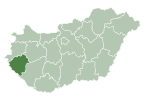|
Zala County
Zala (Hungarian: Zala vármegye, pronounced [ˈzɒlɒ]; Croatian: Zalska županija; županija Zala) is an administrative county (comitatus or vármegye) in south-western Hungary. It is named after the Zala River. It shares borders with Croatia (Koprivnica–Križevci and Međimurje Counties) and Slovenia (Lendava and Moravske Toplice) and the Hungarian counties Vas, Veszprém and Somogy. The seat of Zala County is Zalaegerszeg. Its area is 3,784 square kilometres (1,461 sq mi). Lake Balaton lies partly in the county. History In the tenth century, the Hungarian Nyék tribe occupied the region around Lake Balaton. Their occupation was mainly in the areas known today as Zala and Somogy counties.[3] Parts of the western territory of the former county of Zala are now part of Slovenia (South-Prekmurje) and Croatia (Međimurje). In 1919 it was part of the unrecognized state of the Republic of Prekmurje, which existed for just six days. DemographicsReligion in Zala County (2022 census – of those who declared their religion (62.5%)) Roman Catholic (75.8%) Calvinistic (3.9%) Lutheran (2.1%) Other Christian denomination (4.4%) Other religion (0.3%) Not religious (13.5%)
In 2015, it had a population of 277,290 and the population density was 73 inhabitants per square kilometre (190/sq mi).
EthnicityBesides the Hungarian majority, the main minorities are the Roma (approx. 7,000), Croats (3,500) and Germans (2,000). Total population (2011 census): 282,179
Approx. 38,000 persons in Zala County did not declare their ethnic group at the 2011 census. ReligionReligious adherence in the county according to 2011 census:[6]
Regional structure
PoliticsThe Zala County Council, elected at the 2014 local government elections, is made up of 15 counselors, with the following party composition:[7]
Presidents of the General Assembly
MunicipalitiesZala County has two urban counties, eight towns, two large villages and 246 villages.
(ordered by population, as of 2011 census)
Gallery
ReferencesWikivoyage has a travel guide for Zala County.
External linksWikimedia Commons has media related to Zala County.
|
||||||||||||||||||||||||||||||||||||||||||||||||||||||||||||||||||||||||||||||||||||||||||||||||||||||||||||||||||||||||||||||||||||||||||||||||||||||||||||||||||||||||||||||||||||||||||||||||||||















